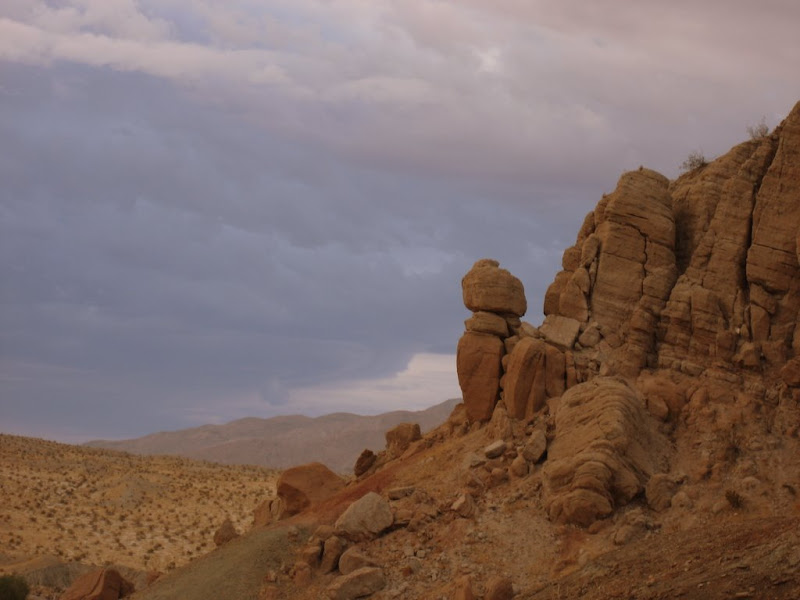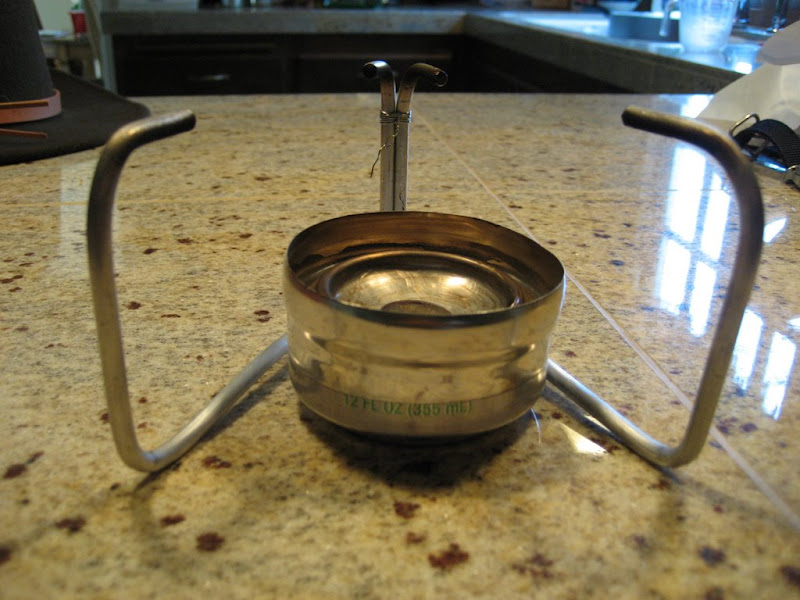OK, the next installment of my mad flurry to update on my
WBC activities.
Our first overnight outing for the WBC was a car camp to Hawk Canyon and the
Borrego Mountain/West Butte area. The trip description called for some time on an unimproved road, so I wussed out and carpooled with the trip's excellent leader Bev. Turns out, she was driving an Outback, so the WRX would probably have been just fine. I'm now taking steps to prep my scoobie for more time on trail head roads like these. (I'll raise the suspension a bit, and fit fore and aft skid plates when I can afford them.)
We'd barely made it to the campsite when things got exciting: A few of our group drove cars even less-suited to the roads than the WRX, (an Avalon and a Jetta), and before we'd even setup camp, we had to dig and push the two of them out of the silty sugar-soft sand of the wash. Lesson learned: If/When I bring the scoobie, I'll be packing a full size shovel, some carpet squares, and a couple of boards.

After setting up a quick car camp, we discussed the impending weather (rain was possibly in the forecast) and decided to reverse the day's destinations. So we set off on foot for "The Slot", a collection of deep crevasses carved by water into the soft earth. This was a really beautiful area, well shaded and an incredible geological record. Its also clearly part of a living ecosystem, as we found scat, evidence of nests, and even the remains of animals that had been prey to small predators. After hiking down The Slot, I was glad we'd switched Saturday and Sunday's destinations, as this was no place to be after even the slightest amount of rain!

I experimented with a new lunch system down here in the slot, with great results. A basic lunch consists of a foil pouch or tuna (or two, depending on package size), combined with condiment packets of mayonnaise and dijon mustard boosted from my work cafeteria. Mix ingredients and apply into a pita, and its a very tasty no-cook trail side meal. The part I'm really happy about is that with whole-wheat pita and fish packed in light oil, I've got a really great combination of carbohydrates and protein to keep myself powered up for the hike. (A hard day's backpack will burn upwards of 4000 calories, this is not the time to be dieting lest you "bonk" in a really dangerous spot.) I'll be packing similar lunches on my next couple of outings, as I'm really happy with the weight-to-calories and the low weight and bulk of the leftover packaging that gets packed out.
After the hike was a car-camp only experience: gourmet hors d’oeuvres and smores! (Potluck style!). I panicked when the trip sheet called for "heavy hors d'oeuvres", so when asked, I punted and said "Fondue". It turns out this really raised the bar for everyone else, so the net experience was too much food, and all of it delicious! For certain friends in-the-know, this analogy will have meaning: Imagine an E-party in the clear desert night air! (For everyone who doesn't get this, I pity you.)

After a windy night, Sunday morning brought the desert beauty I've come to love. I spent the first hour or so after rising exploring Hawk Canyon on my own, and experimenting with various color and ISO settings on my digicam to try to capture the morning light. It never got really cold, but I was glad to have my fleece while leaning on a rock with my mini-tripod trying to setup these shots!

I'm also still working on my self-photography technique, trying to capture myself in as candid a way possible when shooting with a camera 3" off the ground! The lesson learned on this day was: Comb your hair! I made a joke to one of my trip mates that I needed photo evidence for my wife that I really didn't spend the weekend at the tables in Vegas!
Day two also brought another cool hike to the top of Borrego Mountain. This isn't a huge climb, but the valley does drop away from the peak on the north side, so it makes for some cool views from the top. We explored the ridgeline and did some hiking on surfaces that don't show trails well, so we were guided by rock pile
Cairns (which the Sierra Club folks call "ducks"). The wind had been blowing on the way up, but after a stop near the peak for lunch, the gusts started to pick up, and I noticed that the weather was finally threatening to make it over the mountains to the northwest.

What had been fluffy clouds meandering across the afternoon sky were starting to become darker, denser, and faster moving. I pointed this out to Carol, who was leading this particular hike, and the decision was made to boogie back down the mountain. Going downhill is always faster, but I felt a certain sense of urgency too in the decent. By the time we'd neared the cars, the gusts were close to 40 or 50mph (enough to knock me off balance a couple of times, even with trekking poles). After reaching the cars, saying our goodbyes, then negotiating the dirt roads back to the highway, we got about 15 more minutes before the rain hit, and it hit fairly hard. The timing was good, I'd hate to have been up on that ridge in the wind and wet...
All in all, a really fantastic trip. I can't wait for the Land-Navigation trip next weekend.
As usual, my complete trip gallery
can be found here.












